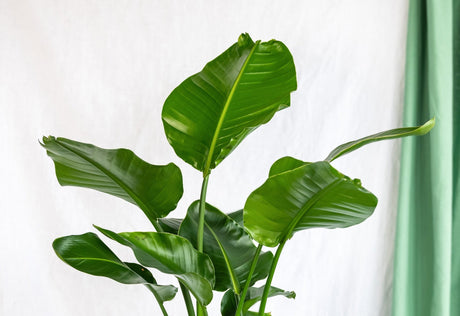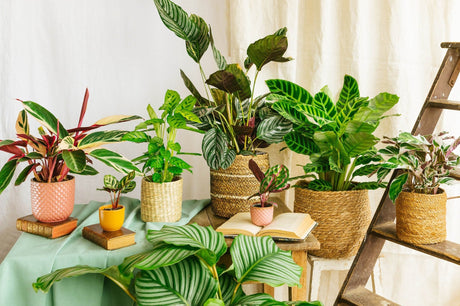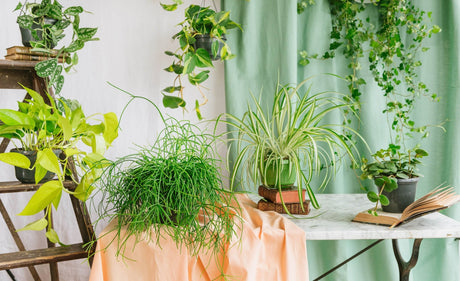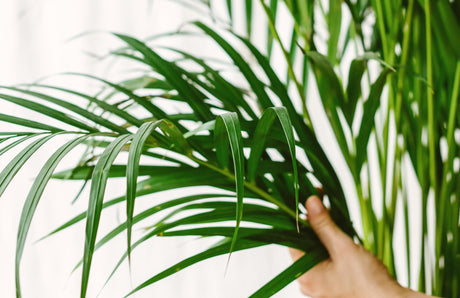The Pothos Epipremnum stands out for its unique characteristics that make it a choice ideal for lovers of plants indoor.
Among the plant gems are Pothos Golden scindapsus epipremnum and Epipremnum Aureum - Pothos XL, two varieties that captivate with their unique character.
The Pothos Golden Scindapsus has leaves that range in color from deep green to yellow vivid, creating dazzling contrast. As a plant drooping , it gives a vertical dimension to your layouts.
For those who prefer a more commanding presence, the Epipremnum Aureum unfolds in a tall plant stately, ready to transform your home or workspace into a true green oasis.
1. Watering the Pothos Epipremnum
Watering is one of the most importantaspects of maintenance of Pothos Epipremnum. Although this plant is renowned for its robustness and its tolerance to conditions variable, it is essential to provide the good quantity of water to guarantee its growth and its health optimal.
The frequency of watering depends on factors such as temperature, l humidity ambient and the season. During the periods of growth active (spring and summer), water your Pothos about once a week. Watch for signs of dry soil between waterings. Reduce the frequency of watering in autumn and winter, as growth slows. Water approximately every two to three weeks.
Tip : Iinsert your finger in the ground to approximately 2-3 centimeters depth. If the soil is dry at this level, it is time to water.
2. Watering techniques
Watering from below
This method involves pouring water into the saucer under the pot. The plant will absorb water through the drainage holes at the bottom of the pot. Take care that the plant does not sit in standing water for an extended period of time.
Top watering
This is the traditional watering method where you pour water directly on top of the soil in the pot. Be sure not to overwater to avoid waterlogging.Watering in the shower
Place your Pothos in the shower or use a gentle stream of water to water the plant. This method mimics natural rain and can help clean leaves of dust.3. The exhibition of Pothos Epipremnum
Pothos Epipremnum thrives under light indirect bright, which means exposure to light of daylight without the direct rays of the sun. Place your plant near a window that receives bright light, but make sure that direct sunlight does not do not hit the leaves of the plant directly. Places where the light is dimmed by a light curtain or a veil are often perfect.
A notable characteristic of the Pothos is its ability to survive in conditions low light. Although it prefers indirect light, it can also thrive in dimmer places, such as rooms away from windows. However, under these conditions, the growth may be more slow and the leaves could be less variegated.
4. When should I repot my Pothos Epipremnum?
Ideally, it is recommended to repot your Pothos every 1 to 2 years, usually at spring or at early summer. However, this frequency may vary depending on the growth of your plant and the current pot size.
Thesigns of a need of repotting
Root crowding
If you notice the roots sticking out of the pot's drainage holes or tangling tightly on the surface of the soil, it's time to repot. Root crowding can impede plant growth and limit its ability to absorb water and nutrients.
Slowed growth
If your Pothos stops growing or new leaves are smaller than normal, this may indicate a lack of root space and a need for more nutrients.
Exhausted soil
If the soil in the pot seems depleted, compacted, or no longer holds water well, repotting can improve the health of the plant by providing it with a new nutrient substrate.
Pot overflow
When the roots have filled the entire space of the pot and the plant can no longer grow freely, you may see signs of overflow like roots sticking out of the drainage holes.
Increased watering frequency
If you find that you need to water more frequently than usual because the soil dries out quickly, this could indicate that the pot is too small for the size of the plant.
5. What fertilizer should I use for my Pothos Epipremnum?
For your Pothos Epipremnum, you can opt for a fertilizer liquid balanced at concentration equal (10-10-10 or 20-20-20) or choose a fertilizer specially formulated for green leafy houseplants. Make sure the fertilizer also contains essential micronutrients such as iron, manganese and zinc.
Application frequency
In general, you can fertilize your Pothos every 4-6 weeks during the active growth period, which is usually spring and summer. In fall and winter, when growth is slower, reduce application frequency to about once every 6-8 weeks.
Organic fertilizer vs. chemical fertilizer
Both types of fertilizer can be used to feed your Pothos. Organic fertilizers release nutrients slowly into the soil, which can be beneficial, but they can also be slower acting. Chemical fertilizers, on the other hand, provide readily available nutrients. You can choose the one that best suits your plant care preferences.
Dilution
Dilute the fertilizer in water according to the instructions on the product label. Too high a concentration can burn the roots of the plant.
6. How do I multiply my Pothos Epipremnum ?
You can propagate your Pothos Epipremnum using the cutting method.
Leaf cuttings
This is a multiplication method. Cut a healthy leaf into sections with a central vein, place them in water to develop roots, then plant the sections in
7. Diseases of Pothos Epipremnum
Pothos Epipremnum is generally a plant robust and easy to maintain, but like all plants, it can be subject to certain diseases. Here are some of the diseases common that can affect Pothos Epipremnum, along with tips for preventing and treating them:
Root rot
Caused by excess moisture or overwatering, root rot can cause roots to become soft and brown. To avoid this, be sure to plant your Pothos in a pot with drainage holes, use a well-drained potting mix, and avoid overwatering.
Powdery Mildew
This fungal disease is manifested by the appearance of a white powdery substance on the leaves. Avoid overwatering, maintain good air circulation around the plant and use appropriate fungicides in case of infection.
Leaf spots
Brown or black spots on the leaves can be caused by temperature fluctuations, excessive humidity or water splashing on the leaves. Avoid watering the leaves and make sure the plant has a stable growing environment.
Yellow leaves
Yellow leaves can indicate excess moisture, over-watering or lack of nutrients. Make sure the plant is properly watered, gets enough indirect light, and is fertilized regularly.
Insects
Insects such as aphids, scale insects and spider mites can attack Pothos. Use natural or commercial insecticide solutions and clean the leaves regularly to prevent infestations.
8. Delivery and reception of your plant
Have you just adopted a plant
- Is your plant dry ? Bathe her for ten minutes.
- Is your plant wet ? Let the potting soil dry.
- Should I repot my plant right away ? No ! Wait until next spring or for signs that your plant needs repotting.






